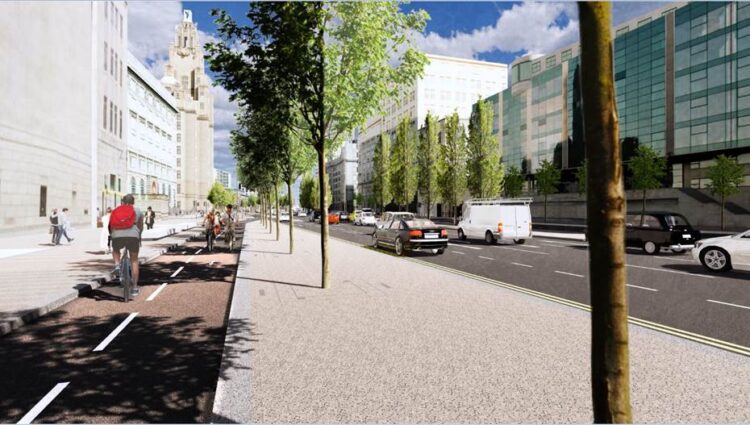Contractors will begin digging up The Strand next week in a project that will include a permanent cycle lane, new trees and public spaces and remodelling to cut congestion. Tony McDonough reports

Contractors will begin digging up one of Liverpool’s busiest roads next week as part of the £22m upgrade.
At 2km long, The Strand is often gridlocked at peak times and Liverpool City Council is to embark on a remodelling of the major city centre route in a bid to reduce congestion and improve safety and air quality.
A major part of the project will see the installation of a permanent segregated cycle lane to connect the south of Liverpool to the north, allowing cyclists to eventually ride the full length of the Mersey from Otterspool to Southport.
New trees and public spaces are also being installed as part of a wider strategy to attract and promote walking in the city centre. Untouched in its design layout since the 1950s, the four-lane dual carriageway has become a hotspot for road accidents with four fatalities in the past two years.
From Monday, June 29 highways specialists Grahams – contractors for the council will start preparations for the revamp. Excavation of the central reservation between Leeds St and Man Island will begin on Wednesday, July 1.
The first phase of the scheme is scheduled to complete in September, with the second phase running from Mann Island to Upper Parliament Street completing in spring 2021.
The redesign of The Strand aims to make the city’s World Heritage listed waterfront, with its docks, museums, venues and cruise terminal, more accessible for pedestrians with both the removal of a traffic lane in each direction and the closure of traffic junctions at Water Street and Mann Island with Goree.
The project is critical to the £47m Liverpool City Centre Connectivity (LCCC) scheme which has already led to changes to Victoria Street and Dale Street, the removal of the Churchill Way Flyover and will also include a revamp of Lime Street and a new coach park.

Cllr Sharon Connor, Cabinet Member for Highways, said: “The Strand’s safety record is appalling. Four fatalities in the past two years in unacceptable and shows what a hazard it is to pedestrians.
“By significantly redesigning how the junctions work we can take a lane out and the traffic will still flow better. As a result we can widen the pavements for pedestrians to ensure a safer experience and install a segregated cycle lane.”
To keep traffic moving along the route, it is proposed that ‘no waiting at any time’ and ‘no loading at any time’ be introduced throughout and around the junctions with adjoining roads.
Based on computer modelling, it is estimated car journeys at peak times along The Strand – from the end of Leeds Street in the north to Upper Parliament Street in the south – will be reduced by more than a minute in both directions.
The significant redesigning of how key junctions are used, including the banning of turns cutting across The Strand, will also ensure traffic flow is more fluid meaning less air pollution, as cars are not stopping starting so frequently.
Preparatory work on the environmental element of the scheme has already begun on The Strand, with the first phase of an environmentally innovative type of tree planting on the central reservation. It is designed to alleviate flooding and will help the city adapt to future climate change.
Cllr Connor added: “Redesigning The Strand has been a huge task and I’m delighted that after all the feedback from residents and businesses we are now at the point where we can begin the change. It is critical to making Liverpool city centre fit for the future – safer, cleaner and greener for everyone to enjoy.”

